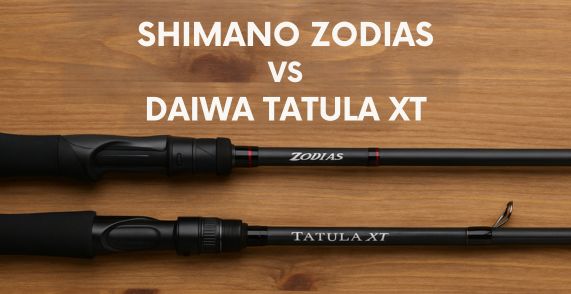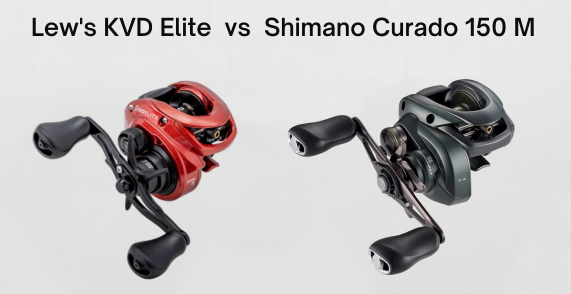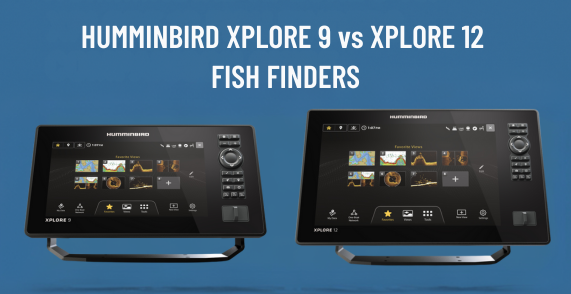Key Takeaways
- The $160 price gap between these rods reflects fundamental differences in component quality—Shimano’s premium Carbon Monocoque handle technology versus Daiwa’s value-engineered approach
- Shimano’s Zodias delivers 1.3x enhanced vibration transmission through its hollow carbon handle, making it superior for precision finesse techniques
- Daiwa’s Tatula XT excels with ultra-light lures as small as 1/16 oz, while the Zodias starts at 1/8 oz minimum weight rating
- The construction differences—single-piece vs. two-piece design—create distinct trade-offs between ultimate sensitivity and transport convenience
- Guide system variations significantly impact casting performance and long-term durability across different fishing scenarios
The bait finesse system (BFS) market presents anglers with a critical decision: invest in premium sensitivity or maximize value without sacrificing performance. These two rods represent opposing philosophies in modern rod engineering, each targeting different segments of the growing finesse fishing community.
In This Post
- 1 $160 Price Gap: Shimano’s Premium vs. Daiwa’s Value Engineering
- 2 Sensitivity Technologies That Separate These Rods
- 3 Guide Systems: Alconite vs. Aluminum Oxide Performance
- 4 Casting Performance and Lure Weight Applications
- 5 Construction Quality: Single-Piece vs. Two-Piece Trade-offs
- 6 Zodias Delivers Premium Sensitivity, Tatula XT Maximizes BFS Value
$160 Price Gap: Shimano’s Premium vs. Daiwa’s Value Engineering
The Shimano Zodias BFS retails for approximately $259.99 while the Daiwa Tatula XT sits at around $99.99—a substantial difference that reflects distinct manufacturing philosophies.
Shimano’s approach centers on maximizing sensory optimization through specialized components, particularly the Carbon Monocoque handle system that requires complex tooling and separate assembly from the blank construction.
Daiwa achieves competitive performance through calculated value engineering. The Tatula XT incorporates sophisticated blank technologies like HVF graphite and X45 bias construction while utilizing cost-effective components such as aluminum oxide guides instead of premium Alconite materials.
Our detailed rod analysis demonstrates how these engineering decisions impact real-world performance across different price points.
This price differential isn’t arbitrary—it represents two fundamentally different approaches to achieving BFS performance.
The Zodias prioritizes component specialization for maximum sensitivity, while the Tatula XT focuses on structural optimization and mechanical value delivery.
Sensitivity Technologies That Separate These Rods
1. Carbon Monocoque Handle: 1.3x Enhanced Vibration Transmission
The Zodias’ revolutionary Carbon Monocoque handle system eliminates traditional EVA foam from the rear grip, creating a hollow carbon fiber structure that transmits vibrations with exceptional clarity.
This technology enhances vibration transmission by approximately 1.3 times compared to conventional grips, allowing anglers to detect subtle substrate changes and delicate bites that would otherwise go unnoticed.
The hollow construction creates an acoustically receptive chamber that channels underwater signals directly to the angler’s hand.
This uninterrupted connection proves invaluable when fishing deep water or high-wind conditions where subtle feedback easily disappears with traditional handle materials.
2. Hi-Power X vs. X45/Braiding-X Construction
Shimano’s Hi-Power X technology applies carbon tape diagonally around the blank’s exterior in opposing directions, creating a rigid spiral lattice that dramatically reduces blank ovalization and twisting.
This construction enhances energy transfer efficiency during casting and fighting fish, resulting in improved accuracy and distance.
Daiwa counters with a multi-layered approach combining X45 bias construction and Braiding-X reinforcement. The X45 system applies 45-degree carbon wraps within the blank to eliminate twist, while Braiding-X adds external reinforcement for increased pulling power.
This compensatory engineering approach ensures structural integrity while maintaining the aggressive price point.
3. Hollow Carbon vs. Traditional EVA Grip Performance
The Tatula XT employs a conventional split-grip EVA handle with Daiwa’s carbon lock nut reel seat—a proven, comfortable design that provides adequate sensitivity transfer through the blank and reel seat connection.
However, EVA foam inherently dampens some vibration compared to the direct carbon resonance achieved by the Monocoque system.
While the Tatula XT’s sensitivity remains excellent for its price class, the difference becomes apparent during technical presentations requiring precise interpretation of underwater conditions.
The Zodias’ hollow carbon grip provides superior signal-to-noise ratio, particularly crucial for competitive anglers who rely on maximum sensory input.
Guide Systems: Alconite vs. Aluminum Oxide Performance
Friction Reduction and Heat Dissipation Differences
The Zodias features Fuji K Alconite guides known for exceptional durability and heat management properties.
Alconite’s superior friction characteristics allow ultra-thin braided and fluorocarbon lines to flow smoothly during casting, reducing heat buildup that can weaken line integrity over time.
Daiwa’s choice of Fuji O Aluminum Oxide guides represents practical cost management without sacrificing reliability.
While aluminum oxide generates slightly more friction and weighs more than Alconite, it provides dependable heat dissipation across all major line types and maintains durability standards suitable for serious fishing applications.
SiC Tip Guide Advantage for Ultra-Light Lines
The Zodias’ Fuji SiC (Silicon Carbide) tip guide minimizes friction to near-zero levels, critical when casting the lightest BFS lures where every fraction of resistance affects distance and accuracy.
SiC’s exceptional smoothness and heat management properties extend line life while optimizing casting performance with ultra-thin lines.
This premium tip guide selection contributes directly to the Zodias’ superior casting distance capabilities and represents a significant component cost that factors into the overall price differential between these rods.
Casting Performance and Lure Weight Applications
1. Tatula XT’s 1/16 oz Minimum vs. Zodias’ 1/8 oz Rating
The Tatula XT’s 1/16 oz minimum weight rating reveals a tip section optimized for ultra-light micro baits—fundamental to true BFS applications.
This counter-intuitive advantage over the more expensive Zodias demonstrates Daiwa’s commitment to authentic BFS performance across the entire weight spectrum.
The Zodias’ 1/8 oz starting point suggests tip optimization favoring crisp recovery speed and hookset power over maximum flexibility under minimal weight.
This design philosophy positions it more as a precision finesse specialist rather than an ultra-light BFS purist tool.
2. Extra Fast vs. Fast Action: Hookset Power Trade-offs
The Zodias’ Extra Fast taper concentrates flex in the upper 10-20% of the blank, delivering immediate, high-power hookset response crucial for penetrating tough bass jaws with light BFS hooks.
This design excels in stationary presentations requiring instant reactivity to subtle bites.
The Tatula XT’s Fast action allows deeper blank loading into the top 30-40%, creating more forgiveness for varying angler skill levels while maintaining effectiveness across the full lure weight range.
This moderate approach proves advantageous for moving baits where shock absorption becomes important.
3. Precision Finesse vs. Power BFS Techniques
These action differences create distinct technique specializations.
The Zodias dominates precision finesse applications like drop-shotting, Ned rigs, and finesse jigs where the Carbon Monocoque handle’s sensitivity advantage translates directly to increased success rates.
The Tatula XT embraces “power BFS” methodology, handling small chatterbaits, swim jigs, and lightweight crankbaits with structural confidence. Its HVF and Braiding-X reinforcement provides the backbone necessary for aggressive bass fishing while maintaining finesse capabilities.
Construction Quality: Single-Piece vs. Two-Piece Trade-offs
Blank Continuity and Sensitivity Impact
Single-piece construction in many Zodias models maintains uninterrupted blank continuity, theoretically providing optimal vibration transmission and structural integrity.
This design eliminates any potential weak points or sensitivity losses associated with joint connections.
The Tatula XT’s construction varies by model, with some featuring two-piece designs with “Put In” joint construction representing acceptable performance compromise in favor of cost efficiency and practical benefits.
While joint connections can theoretically impact sensitivity, modern manufacturing techniques minimize these effects in real-world applications.
Transport Convenience vs. Performance Optimization
Two-piece Tatula XT models offer crucial practical advantages for bank anglers and frequent travelers, providing compact storage and transport solutions without requiring specialized rod cases.
This accessibility factor enhances the rod’s value proposition for many recreational anglers.
Single-piece Zodias models demand dedicated storage and transport considerations, aligning with their positioning as specialized performance tools for serious enthusiasts willing to accommodate these requirements for ultimate sensitivity.
Zodias Delivers Premium Sensitivity, Tatula XT Maximizes BFS Value
The choice between these rods ultimately depends on individual priorities and fishing applications. The Shimano Zodias BFS represents the clear choice for anglers demanding maximum sensitivity and willing to invest in premium component technology.
Its Carbon Monocoque handle, superior guides, and specialized construction justify the price premium for competitive anglers and finesse specialists.
The Daiwa Tatula XT BFS democratizes advanced BFS technology, delivering sophisticated blank construction and reliable performance at an accessible price point.
Its versatility across the ultra-light spectrum, practical design options, and structural durability make it ideal for newcomers to BFS or value-conscious anglers requiring dependable performance.
Both rods successfully address different segments of the BFS market, with the Zodias targeting sensitivity optimization and the Tatula XT focusing on structural integrity and accessibility.
The substantial price difference reflects genuine engineering disparities rather than marketing positioning alone.






